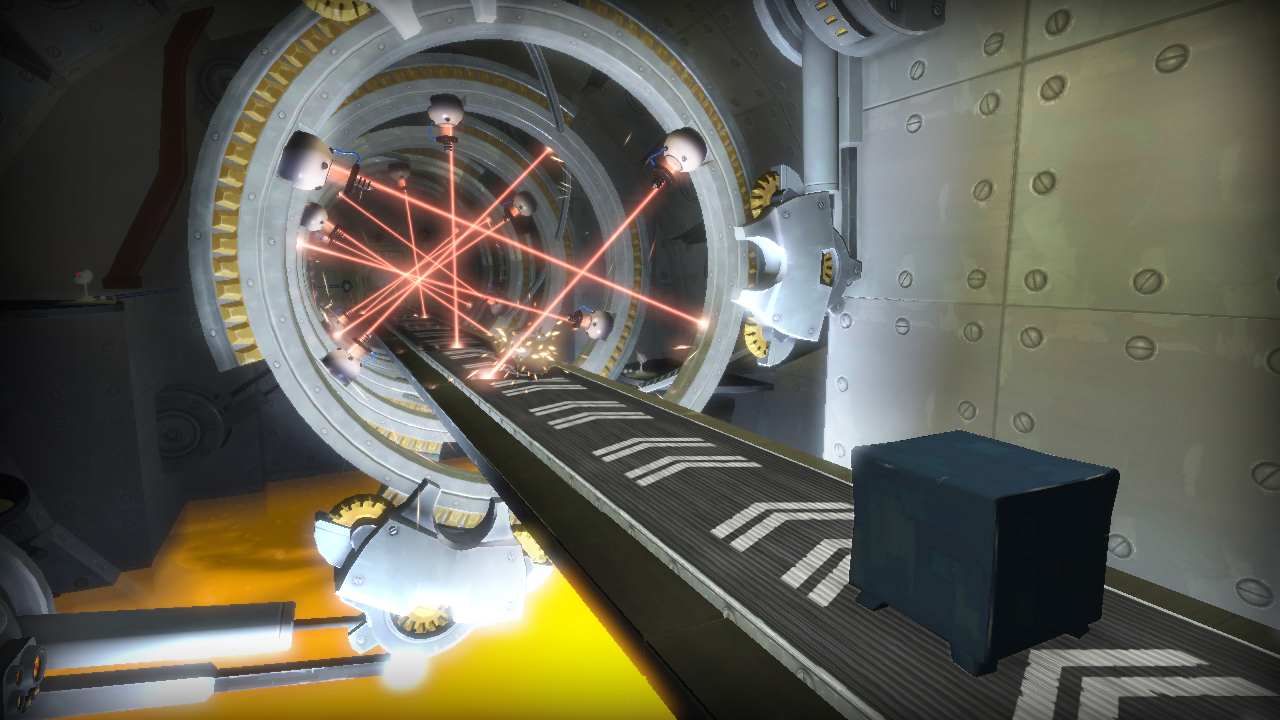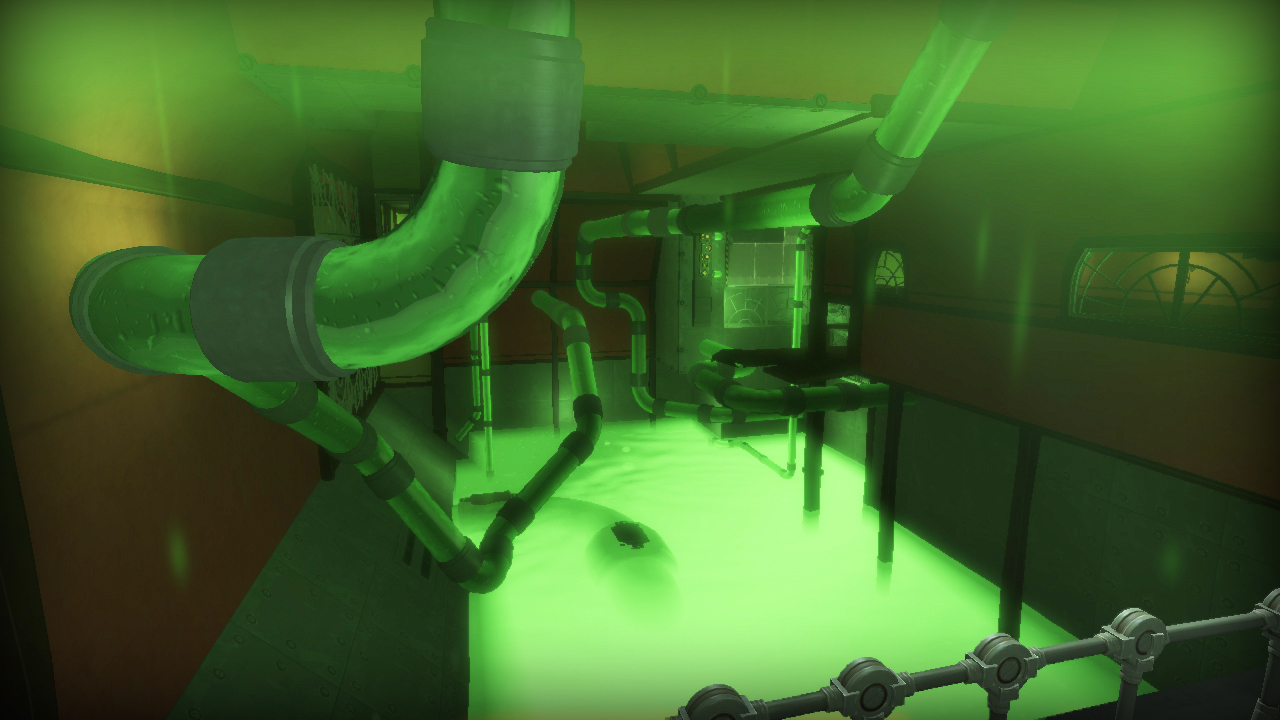
Portal is one of my favorite games of all time. I love it so much that I even learned to play “Still Alive” on the ukulele. Knowing that Kim Swift, the Portal designer who went on to join Airtight Games, led Quantum Conundrum’s development only added to my intense anticipation for this title.
Journalists have quoted Swift saying that she wants to create games that are accessible to a wider market with enough challenge to satisfy more experienced players. Quantum Conundrum is a fantastic attempt at doing just that even if it doesn’t quite hit all the bullet points that such a widely appealing yet core-gamer-pleasing experience would need to have. It isn’t perfection, but it’s a brilliant try all the same.
Players will take on the role of a young child, aged somewhere between 10 and 12, who visits his wacky mad-scientist uncle’s house every year. This time, the boy arrives to find his relative missing and only able to communicate by voice. Professor Fitz Qwadrangle is the uncle’s name, and science-juice-fueled dimensional trickery is his game. With the aid of a dimension switching glove and several “batteries,” the player must move through each environment to ultimately restore power to three generators throughout the seemingly endless corridors and rooms of Qwadrangle Mansion.
WHAT YOU’LL LIKE
Dimensional shifting is a delight
The central gameplay mechanic here is that of changing the environment’s basic physical laws along fairly straightforward lines to access areas and avoid obstacles along the way.
In the fluffy dimension, all objects weigh far less than they otherwise would. Players can pick up and fling safes and couches with ease. The heavy dimension is the polar opposite: Objects have incredible weight, allowing cardboard boxes to trigger pressure plates and open remote doors. The gravity dimension reverses that force of attraction so that items will fall up. The slow dimension forces the flow of time to a crawl, allowing all sorts of tricks to occur, like jumping through a deadly spinning fan blade or tossing a table to jump on to float over and across large expanses of flooding, fatal science juice.
The real fun, however, comes in combining the different dimensional shifts in concert and with precise timing to achieve the goal in each section. Later levels have players manipulating time, gravity, and weight to move a safe from point A to point Q past laser beams, walls, conveyor belts, and more just to drop it on a pressure plate to open a door. When the player shifts dimensions correctly, he’ll experience an amount of zen concentration not unlike that of an conductor waving a baton to keep an orchestra playing along masterfully.
Level design brilliance
If one thing shines forth in Quantum Conundrum, it’s the beauty of the level design. Even the brutally difficult areas contain their own solutions, which become obvious with some attention, observation, and testing. None of the stages felt unfair or simply tricks: Each well-executed set of obstacles and solutions felt extremely satifsying to both suss out the answer and then execute perfectly to reach the end area.
Even the levels that required twitch-perfect timing and near-genius platforming skills felt like I could master them with just another try, just one more go. The puzzles are never too hard to figure out yet remain just one step ahead of the previous solution to constantly guide players to ever more epic amounts of effort and insanity.
Voice-overs matter
Professor Qwadrangle is a brilliantly acted character voiced to melodramatic perfection by John DeLancie, best known for his role on Star Trek as Q, the multi-dimensional being from the Q Continuum. His character in Quantum Conundrum is at turns hilarious, sarcastic, acerbic, and informative. He shows concern for his nephew throughout the twists and turns of the mansion but never as much as his worry for his house, his possessions, and — heaven forbid — the amount of damage players need to do to progress to the next section.
Qwadrangle never quite reaches the genius malevolence of GlaDOS, Portal’s antagonist, herself, but his constant companionship provides a needed through-line for players to want to reach the next section, the next checkpoint, and, yes, the end of the story.
Humor is key
This is a cute game, but mostly, it is funny. The pictures on the wall change with each dimensional shift, which alters the subjects of each painting with fluffy outfits, gravity-defying situations, or heavy medieval armor, depending. Little collectibles on each level holler out inappropriate noises, like dolphin, eagle, or cheetah cries. The written dialogue can be hilarious, and the death screens detail the numerous things players won’t be able to experience now that they’re dead. Each one is a joy to see even while screaming in frustration from a just-missed jump to a floating safe.
WHAT YOU WON’T LIKE
The ending
No spoilers here, honest, but the ending is a rather flat affair. The number of hours I spent figuring out the puzzles and listening to the tantalizing hints of what actually went wrong with the dimensions and Qwadrangle Manor ended abruptly and with an odd lack of finesse in the final hour. It’s a backhanded complement to say so, however, as the rest of the game’s story, environment, and level design led me to expect big things from the end game. Sadly, big things do not materialize.
Touchy, floaty, and frustrating platforming
While Quantum Conundrum exhibits strong level design, the extremely touchy controls and overly floaty jumping mechanic makes the platforming needed to execute the solutions all the more difficult when maneuvering the main character around the levels.
It feels odd to say this about a game in which players are manipulating the very forces of gravity, but the physics of guiding an object through a complex series of hazards and obstacles never felt very predictable. It’s hard enough to remember what specific dimension I am shifting to or from without the added overly long jump or underperforming safe-toss to keep mein a holding pattern long after I’ve solved the conundrum of each area.
Hub transitions are hard
What gave me the most trouble wasn’t the difficult controls or unpredictable physics but the two odd areas that I ened up in after the first and third wings of the mansion.
After each large level, players return to the great hall, a hub of sorts, where they can access the next wing or go back to previously completed sections to engage in masochistic speed runs if they so desire. What whacked me out, however, was an area just off this hub room that I later found out to be a playroom of sorts. It felt just enough like a puzzle level that I wasted a good hour or so in there just trying to figure out the solution. I would have welcomed adding a simple sign or even a sarcastic voice-over prompt here.
The final wing of the mansion is in an out of the way area that is not readily found. The visual cues that took place after I activated the third and final generator all had me trying to jump on a big, revolving, planetarium-like structure in the center of the hub room with no success for quite some time until I had to beg the developers for a hint. When I found out I wasn’t even in the final wing and was basically jumping around in an area that had nothing to do with finishing the game, I face-palmed and continued. This is no way to make a game that has such elegantly intuitive puzzle design.
CONCLUSION
Quantum Conundrum is similar enough to Portal to give us all a thrill when playing it. It’s not, however, a simple iteration of the Portal formula — that was Portal 2, an experience that left much to be desired in it’s recapitulation of the earlier hit title.
I found plenty to engage my brain and my senses in Quantum Conundrum; although, I could have done without the irrelevant “cute” mascot, Ike, as well as the overly sensitive controls and inconsistent character mobility physics. The humor and emergent storyline — while not as utterly sparkling as it could be — serves its purpose well, encouraging and rewarding me for moving through even the more conniption-inducing moments of brutal twitch-platforming or clueless pathfinding I found myself in.
Bottom line, this game is a fine way to spend several hours for a fine price as well. The challenges will please more core gamers while the comprehensible level design will likely attract new players attracted to the art style and refreshingly different gameplay mechanics. I recommend it heartily to fans of Portal (either version) as well as gamers who may be suffering from shooter fatigue. The more quirky little games like this that we can support with our dollars, the better the ecosystem will become.
Score: 84/100
[vb_gallery id=478274]
VentureBeat's mission is to be a digital town square for technical decision-makers to gain knowledge about transformative enterprise technology and transact. Learn More


